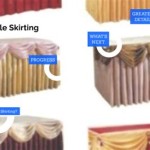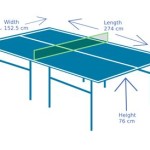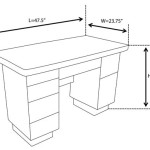How to Varnish a Tabletop: A Comprehensive Guide
Varnishing a tabletop is a process that enhances its appearance, protects the wood from damage, and extends its lifespan. A properly varnished tabletop resists scratches, stains, and moisture, making it ideal for everyday use. This article provides a detailed guide on how to varnish a tabletop, covering preparation, application, and post-varnish care.
Preparing the Tabletop for Varnishing
The success of a varnishing project hinges on thorough preparation. A clean, smooth surface is crucial for the varnish to adhere properly and provide a flawless finish. Neglecting these initial steps can lead to imperfections in the final result, requiring additional work to correct.
The first step is to thoroughly clean the tabletop. Remove any existing finishes, dirt, grease, or wax. For tables with old varnish, using a chemical stripper is often the most efficient method. Apply the stripper according to the manufacturer's instructions, allowing it to soften the existing finish. Once softened, carefully scrape off the old varnish using a plastic scraper to avoid damaging the wood. Multiple applications may be necessary for thick or stubborn finishes. Ensure adequate ventilation when using chemical strippers, and wear appropriate protective gear, including gloves and eye protection.
After removing the old finish, clean the tabletop with mineral spirits to remove any residue from the stripper. Wipe the surface thoroughly with clean cloths, changing them frequently to prevent re-deposition of the removed finish. Allow the mineral spirits to evaporate completely before proceeding to the next step.
Next, sand the tabletop. Start with a coarser grit sandpaper (e.g., 80-grit or 100-grit) to smooth out any imperfections and level the surface. Move to progressively finer grits, such as 150-grit, 220-grit, and finally 320-grit. Sand with the grain of the wood to avoid creating scratches that will be visible through the varnish. Use a sanding block to ensure a consistent and even sanding pressure. For intricate details or hard-to-reach areas, consider using a detail sander or sanding sponges.
Between each sanding stage, remove the sanding dust thoroughly. A vacuum cleaner with a brush attachment is effective for removing the bulk of the dust. Follow this with a tack cloth to pick up any remaining fine particles. A tack cloth is a slightly sticky cloth that effectively removes dust without leaving residue. Ensure the tabletop is completely dust-free before applying the varnish.
Inspect the tabletop for any defects, such as cracks, dents, or gouges. Fill these imperfections with wood filler that matches the color of the wood. Apply the filler according to the manufacturer's instructions, and allow it to dry completely. Once dry, sand the filled areas smooth with progressively finer grits of sandpaper, blending them seamlessly with the surrounding wood. Remove all sanding dust again before proceeding.
Finally, wipe the tabletop with a clean, damp cloth to raise the grain. This will cause the wood fibers to swell, allowing you to sand them off for an even smoother finish. Allow the wood to dry completely, and then lightly sand it again with a very fine grit sandpaper (e.g., 320-grit or 400-grit). Remove all sanding dust, ensuring the surface is completely clean and smooth.
Applying the Varnish
The application of varnish requires careful attention to detail and the use of appropriate techniques. The goal is to achieve a smooth, even coat without drips, runs, or brush marks. Selecting the right type of varnish and using the correct application method are critical for achieving a professional-looking finish.
Choosing the right type of varnish is essential for the project's success. There are several types of varnish available, each with its own characteristics and suitability for different applications. Oil-based varnishes are durable and provide a warm, amber tone, but they tend to yellow over time. Water-based varnishes are more environmentally friendly, dry faster, and are less prone to yellowing, but they may not be as durable as oil-based varnishes. Polyurethane varnishes are highly durable and resistant to scratches and moisture, making them a good choice for tabletops subject to heavy use. Spar varnishes are designed for outdoor use and offer excellent UV resistance and flexibility. Consider the intended use of the tabletop and the desired aesthetic when selecting the type of varnish.
Before applying the varnish, prepare the work area. Ensure adequate ventilation to allow the varnish fumes to dissipate. Cover the surrounding surfaces with drop cloths to protect them from spills and splatters. Wear appropriate protective gear, including gloves and a respirator, to avoid inhaling the varnish fumes and getting the varnish on your skin.
Stir the varnish thoroughly before use. Avoid shaking the can, as this can create bubbles that will be trapped in the finish. Use a clean stirring stick to gently mix the varnish from the bottom of the can to the top, ensuring that all the solids are evenly distributed. Let the varnish sit for a few minutes to allow any bubbles to dissipate before beginning the application.
Apply the varnish in thin, even coats using a high-quality brush. Natural bristle brushes are generally recommended for oil-based varnishes, while synthetic bristle brushes are preferred for water-based varnishes. Dip the brush into the varnish, and then tap off any excess against the side of the can to avoid overloading the brush. Apply the varnish with long, smooth strokes, following the grain of the wood. Overlap each stroke slightly to ensure complete coverage. Avoid applying too much varnish at once, as this can lead to drips and runs.
After applying the first coat, allow it to dry completely according to the manufacturer's instructions. Drying times can vary depending on the type of varnish, the temperature, and the humidity. Avoid touching the varnished surface while it is drying, as this can leave fingerprints or other marks. Once the first coat is dry, lightly sand it with a very fine grit sandpaper (e.g., 320-grit or 400-grit) to remove any imperfections and create a smooth surface for the next coat. Remove all sanding dust before applying the next coat of varnish.
Apply subsequent coats of varnish in the same manner as the first coat. Two to three coats are typically sufficient for a durable and attractive finish. Lightly sand between each coat to ensure a smooth surface. With each coat, the finish will become more durable and resistant to scratches and stains.
For a glass-like finish, consider wet sanding the final coat of varnish. Wet sanding involves using very fine grit sandpaper (e.g., 1000-grit or 2000-grit) with water to create an ultra-smooth surface. Add a few drops of dish soap to the water to help lubricate the sandpaper. Sand the varnished surface gently, using light pressure. Rinse the surface frequently with clean water to remove the sanding slurry. Once you have achieved the desired smoothness, wipe the surface dry with a clean cloth.
Post-Varnish Care and Maintenance
Proper care and maintenance are essential for preserving the beauty and durability of a varnished tabletop. Regular cleaning and protection from damage will help extend its lifespan and keep it looking its best for years to come. Understanding the appropriate cleaning methods and protective measures is critical for maintaining the finish.
Allow the varnish to cure completely before using the tabletop. Curing is the process by which the varnish hardens and reaches its maximum durability. Curing times can vary depending on the type of varnish, but it typically takes several days to a week. Avoid placing heavy objects on the tabletop during the curing process, as this can leave marks or indentations in the finish. Follow the manufacturer's instructions for curing times and any specific recommendations.
Clean the varnished tabletop regularly with a soft, damp cloth. Avoid using harsh chemicals or abrasive cleaners, as these can damage the varnish. For stubborn stains, use a mild soap solution, but be sure to rinse the surface thoroughly with clean water and dry it immediately. Avoid leaving water or other liquids on the surface for extended periods, as this can cause the varnish to become cloudy or damaged.
Protect the tabletop from scratches and dents by using placemats and coasters. Place mats under dishes and other items that could potentially scratch the surface. Coasters should be used under glasses and cups to prevent water rings. Avoid dragging heavy objects across the tabletop, as this can cause scratches or gouges.
Consider applying a furniture polish to the varnished tabletop periodically to enhance its shine and provide an extra layer of protection. Choose a furniture polish that is specifically designed for varnished surfaces and follow the manufacturer's instructions. Apply a small amount of polish to a soft cloth and buff the surface gently. Remove any excess polish with a clean cloth. Polishing the tabletop will help maintain its luster and protect it from minor scratches.
Avoid exposing the varnished tabletop to extreme temperatures or humidity levels. These conditions can cause the varnish to crack or peel. If possible, keep the tabletop in a climate-controlled environment to maintain consistent temperature and humidity levels. Avoid placing the tabletop near heat sources, such as radiators or fireplaces, as this can cause the varnish to dry out and crack.
If the varnished tabletop becomes damaged, repair it promptly to prevent further damage. Small scratches can often be repaired with a touch-up pen or furniture polish. Deeper scratches or gouges may require more extensive repairs, such as filling with wood filler and re-varnishing the affected area. Consult a professional furniture restorer for significant damage.

Best Tabletop Finish Finewoodworking

Staining Refinishing A Table Top How To Guide

How To Finish A Wood Table Ask This Old House

Dining Room Table Makeover Refinishing A Wood Veneer Stacy Risenmay

How To Finish A Desk Table Top Bunnings Work Community

How To Refinish A Dining Table Without Stripping The Original Coat

How To Finish A Wood Table Ask This Old House

How To Finish A Farmhouse Table

How To Finish A Desk Table Top Bunnings Work Community

How We Apply A Varnish Finish On Wood Gary Weeks Company








